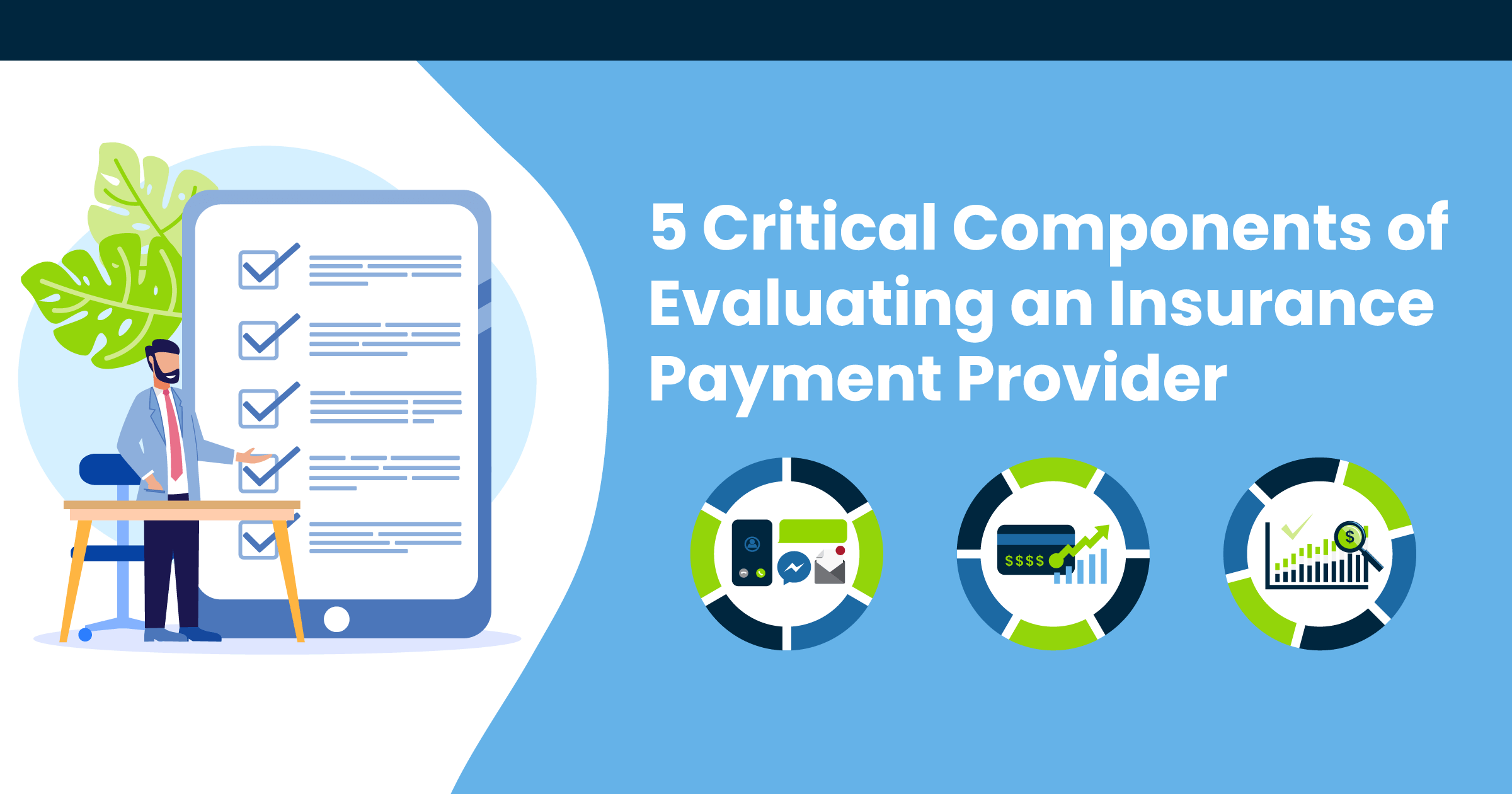
5 Critical Components of Evaluating an Insurance Payment Provider
 Imagine buying a new home based on a single photo, without checking the location, size, or condition of the property prior to purchase. While this scenario may seem unrealistic, it is essentially what company leaders are doing when they select a digital payments provider on merchant services alone.
Imagine buying a new home based on a single photo, without checking the location, size, or condition of the property prior to purchase. While this scenario may seem unrealistic, it is essentially what company leaders are doing when they select a digital payments provider on merchant services alone.
With nearly nine in ten U.S. consumers now routinely using one or more digital payment methods,1 insurers are rapidly increasing their range of digital services to boost revenue and improve the policyholder experience. However, to reap those business benefits, insurance carriers need to first choose a qualified digital payments provider by evaluating five critical components:
- The user interface (UI) and user experience (UX)
- Payment types and digital wallet acceptance
- Authorization approvals
- Cost optimization
- Integrations with core systems
The User Interface (UI) and User Experience (UX)
Payments are the most frequent touchpoint between a policyholder and their insurer.2 So it makes sense that the user interface (UI) and user experience (UX) of an insurer’s payment platform would contribute significantly to the policyholder’s overall experience.
If the UI displays the payment provider’s branding as opposed to the insurer’s or forces the policyholder to go to a third-party site to make a payment, feelings of distrust can easily form. On the other hand, using the same branding elements as the insurer promotes a feeling of trust and helps to prevent any confusion or concern caused by a site that looks off-brand.
The last thing an insurer wants is for a policyholder to feel uneasy when making a premium payment. Other key components to be considered involve the variety of payment channels offered (e.g., payment modals, interactive voice response, mobile, and pay-by-text), the existence and ease of insurer configurability, and the presence of policyholder self-service options.
Payment Types and Digital Wallet Acceptance
It’s not just Millennials and Generation Zers who use digital payments. People between the ages of 50 and 64 years old make up the largest portion of PayPal users in the U.S. at 29%.3 And 3.4 billion people globally used digital wallets in 2022.4
When choosing a provider, insurance carriers should look beyond the payment methods they accept currently, such as credit and debit cards, to include alternative payment methods like Apple Pay®, Google Pay™ and other digital wallets. Per PYMNTS, 21% of consumers surveyed used digital wallets to pay their insurance premiums.5
To accept today’s popular payment methods and build for the future, carriers should seek a digital payments provider that is continually working on next generation technology. This type of forward-thinking partner gives carriers the flexibility to easily add more payment types when they feel the time is right for their business.
Authorization Approvals
If a transaction appears even slightly suspicious, the card issuer can decline to authorize it, meaning many genuine transactions can end up being declined. Called “false declines,” they occur quite often. In just one month, January 2022, over 10% of consumers experienced payment declines, according to PYMNTS research.6
To increase the percentage of approved transactions, selecting a payments provider with network tokenization is crucial. Network tokenization allows card brands to go directly to the issuing bank when verifying the card’s legitimacy. These transactions are considered more secure and trusted, giving the issuing and acquiring banks more confidence in the transactions’ authenticity. Per Visa, transactions using network tokens can reduce fraud by nearly 26% and increase authorization rates by an average of 2.2%.7
Automatic updates to expired or reissued cards can also lessen declines for recurring payments and other card-on-file transactions — further optimizing payment acceptance.
Cost Optimization
Factors that affect card processing costs include the card network, whether it’s a credit or debit card, and the type of card.8 While these factors cannot be controlled, mechanisms like network tokenization and least cost routing (LCR) can significantly reduce card acceptance costs.
Insurers looking to optimize interchange should partner with a provider proficient in running payments through the card networks. Using network tokens allows insurers to qualify for reduced interchange rates, saving 66% or more on credit card expenses.9
LCR is another mechanism that optimizes interchange by directing debit card payments through the most cost-effective network for merchants. Payment processors must quickly analyze transaction details to identify the lowest-cost routing option. Providers with multiple network connections offer broader coverage and cost savings — reducing interchange and switch fees by up to 40%. 10
Integrations with Core Systems
Integrating third-party payment data with core insurer systems can be complex, but it quickly becomes more challenging when legacy technology is involved. Insurance carriers should seek a digital payments platform with a flexible architecture that offers a seamless integration path. This type of provider is essential for insurers that want to minimize development effort and deployment time — whether the integration is via API or flat file.
For modern billing, premium, and claim systems, integration accelerators (pre-built code packets) can significantly reduce the burden on IT areas and increase speed to market. Accelerators are downloaded by the carrier (or a systems integrator) from a core provider's app store or marketplace and consumed by an on-premise core system, requiring much less development work than custom integrations.
Additionally, some payments platforms have out-of-the-box integrations with cloud-based core systems that include pre-configured settings and features. These embedded solutions require the least amount of time and effort for carriers to implement — giving them an even faster and more seamless transition to digital payments.
A Holistic View of Digital Payments
All aspects of handling payments are interconnected. And each plays a role in driving innovation, reducing costs, and creating an exceptional policyholder experience. To select the best digital payments platform for their specific needs and goals, insurance carriers should conduct a holistic assessment of five critical components: UI/UX, payment types, authorization approvals, cost optimization and integrations.
At One, Inc we provide seamless digital payment experiences that allow insurers to deliver more to their policyholders. Learn more.
Want to dive deeper into each component of evaluating a payments provider? Download our whitepaper Evaluating Payments Providers: A Playbook for Success in the Insurance Industry.
Sources:
1 McKinsey – https://www.mckinsey.com/industries/financial-services/our-insights/banking-matters/consumer-trends-in-digital-payments
2 Insurance Thought Leadership – https://www.insurancethoughtleadership.com/customer-experience/changing-expectations-mobile-payments
3 Moneyzine – https://moneyzine.com/personal-finance-resources/paypal-statistics/
4 Juniper Research – https://www.juniperresearch.com/press/digital-wallet-users-exceed-5bn-globally-2026
5 PYMNTS – https://www.pymnts.com/study/mobile-wallet-challenge-bill-pay-consumer-finance-instant-payments/
6 PYMNTS – https://www.pymnts.com/study/digital-economy-payments-consumer-retail-travel-spending-ecommerce/
7 Visa – https://navigate.visa.com/na/money-movement/why-2021-is-set-to-be-the-year-of-the-token/
8 Forbes – https://www.forbes.com/advisor/business/interchange-fees/
9 Fiserv – https://www.carat.fiserv.com/en-us/resources/network-token-benefits/
10 Fiserv – https://www.carat.fiserv.com/content/dam/carat/us/en/pdf/debit-routing-sales-sheet.pdf

Written by The One Inc Content Team
The One Inc Content Team strives to provide valuable insights about digital trends and payments innovation for the insurance community.
Want to read more articles like this?

